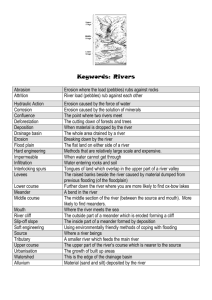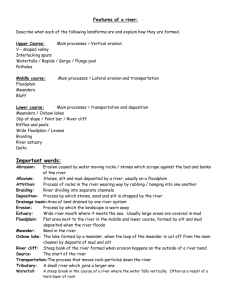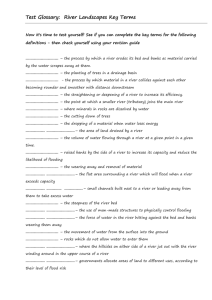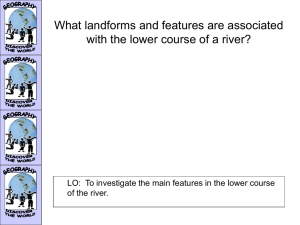Unit 1.3B_4 River Landforms
advertisement
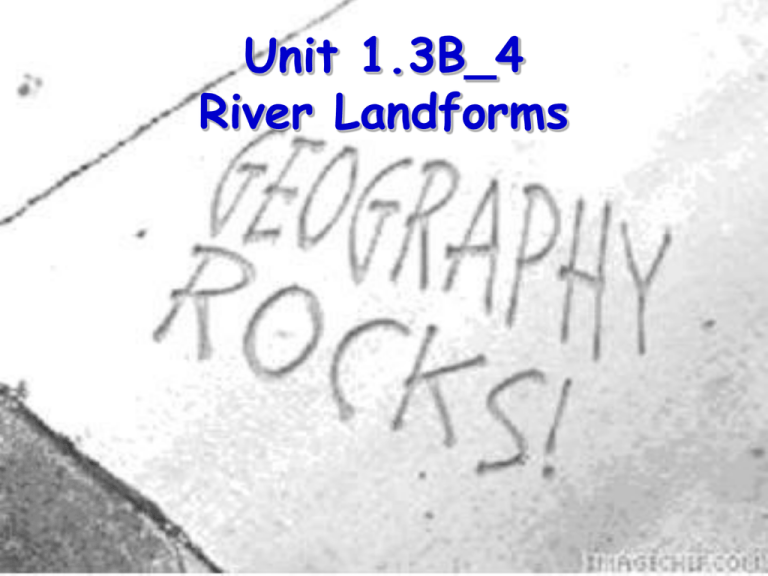
Unit 1.3B_4 River Landforms Now you know a bout the processes that enable the river to change • What does the river look like? River Valley Development A river has a life cycle from source to mouth. The processes at work cause changes to the river valley and river features in the landscape that it passes over. Traditionally this cycle has been described in 3 stages, the Upper (Torrent) section, the Middle (Valley) section and the Lower (Flood Plain) section. The terminology's Youthful, Mature and Old have also been used to describe the sections. The stages are not clearly defined but merge from one to the other and rivers show individual characteristics. There are river features that can be defined within a broad pattern. A typical long profile: upper middle lower Upper Course Characteristics: •Deep narrow valley •(V shaped) •Interlocking spurs •Fast flowing river (erosion predominant) •Pot holes in the river bed •Rapids and Waterfalls The main process at work is the downward or vertical erosion of the stream bed. This cuts into the landscape deepening the valley sides. In the Upper Course • You see V-shaped valleys, interlocking spurs, • • • • waterfalls, gorges and rapids. This because the erosion takes place downwards only - Vertical erosion This mainly by abrasion and hydraulic action, making valley deeper Most of the transport is by traction and saltation. As the main work is vertical erosion, the water winds it way around obstacles, weaving from side to side – the point on the valley side ahead is worn away, increasing the cut into the valley side – hense V-shaped valley with interlocking spur Potholes: Potholes are formed by corrasion. Pebbles carried by the river are swirled around on the riverbed. This action erodes the rock on the riverbed forming potholes. Over time, they may widen and join with other potholes to form larger potholes, and the whole riverbed is deepened. Fast flowing water has more energy Slip-off slope River cliff forms Slow, shallow water and deposition on the inside of the bend Deep, fast water and erosion on the outside of the bend • As the outer banks of a meander continue to be eroded through processes such as hydraulic action the neck of the meander becomes narrow and narrower. Oxbow lakes • Eventually due to the narrowing of the neck, the two • • • outer bends meet and the river cuts through the neck of the meander. The water now takes its shortest route rather than flowing around the bend. Deposition gradually seals off the old meander bend forming a new straighter river channel. Due to deposition the old meander bend is left isolated from the main channel as an ox-bow lake. Over time this feature may fill up with sediment and may gradually dry up (except for periods of heavy rain). When the water dries up, the feature left behind is known as a meander scar. Levees (thanks to Mark Bailey) What are they? Often several metres higher than the river’s floodplain, they are high natural embankments of silt situated close to the river channel. Where are they found? They are most commonly found in the lower course of a river where there is a floodplain, along rivers that flood periodically, have a slow flow and carry large amounts of load. How are they formed? The river before the flood at regular height. The river whilst flooding There is an increase in friction between the water leaving the channel and the floodplain when a river overflows. The water is shallower on the river banks and valley floor, thus this is why deposition of load occurs. After repeated flooding causing the deposition of silt onto the banks, this eventually settles which over time builds up to form a levee. The coarser material is deposited first, and is positioned closer to the river. After repeated flooding, the river bed and levees are raised due to the constant process of the deposition of silt. Over time, this eventually causes the river to rise above level of flood plain. This is called an ‘aggraded bed’. The end of the river • Eventually the river flows into a lake or a sea or an ocean. • If the water it flows into has little current, any remaining silt is dropped as it enters and there is no current to remove it and a delta forms. Mississippi Delta But in the UK … • There are plenty of currents to wash away any silt that is dropped and so our rivers have mouths instead. • I google-mapped this one. Where is it?

